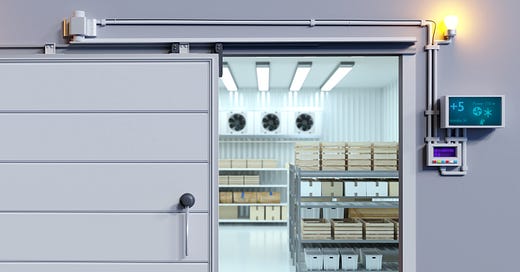The hidden climate cost of cold storage and refrigerants
How refrigeration fuels climate change - and what we could do about it
The cold storage industry plays a vital role in preserving temperature-sensitive goods, from food to vaccines. Once named ‘the most important invention in the history of food and drink’ by the Royal Society, they are both ubiquitous and indispensable in modern society.1 However, its operations contribute significantly to greenhouse gas emissions. Central to this issue are refrigerants—chemical compounds used in cooling systems—that can trap heat in the atmosphere up to 25,000 times more effectively than carbon dioxide.2 Cold storage facilities, often requiring temperatures below -50°C, also consume substantial amounts of energy, much of which is sourced from fossil fuels. According to the International Energy Agency, refrigeration accounts for approximately 5% of global energy use and 2.5% of total greenhouse gas emissions annually.3
How refrigerants work
Refrigerants have been cooling our world for over a century, evolving from early ice makers to modern air conditioning, supermarket freezers, and industrial chillers. They operate by cycling between liquid and gas states to absorb and release heat. Today, refrigerants are crucial in various sectors, with data centers standing out as one of the largest consumers due to their immense cooling requirements.
What is causing the emissions?
The environmental impact of refrigerants stems primarily from their leakage into the atmosphere. Ideally, refrigerants would operate in a closed system, but at the end-of-life stage, gaps in recovery and recycling processes often lead to significant emissions. This is particularly problematic for high-GWP refrigerants such as HFCs, which, if released, have a devastating impact on global warming. For instance, just 1kg of the common refrigerant R-410A has a warming potential equivalent to 2,088kg of CO₂.4
Moreover, variable refrigerant flow (VRF) systems, which circulate refrigerants between indoor and outdoor units, are prone to leakage, contributing significantly to the whole-life carbon emissions of buildings. For such systems, annual refrigerant leakage rates can reach 6%, with additional emissions at end-of-life if recovery practices are inadequate.5
Predominant refrigerants and legislative interventions
Most refrigerants today are synthetic compounds categorized as fluorinated gases (F-gases), including hydrofluorocarbons (HFCs), perfluorocarbons (PFCs), and sulphur hexafluoride (SF6). Although widely used in air conditioning, refrigeration, heat pumps, and industrial cooling systems, the environmental impact of these gases is significant. With some having a GWP thousands of times higher than carbon dioxide, they have been dubbed “supergreenhouse gasses”.6
Earlier generations of refrigerants, such as chlorofluorocarbons (CFCs), were found to deplete the ozone layer, prompting the adoption of regulations like the Montreal Protocol, which phased out ozone-depleting substances. However, their replacement (HFCs), while ozone-safe, still carried high GWP.
To mitigate these impacts, international agreements like the Kigali Amendment to the Montreal Protocol aim to reduce HFC emissions by 80% by 2047, preventing emissions equivalent to 105 million tonnes of CO₂e. This has spurred innovation in third-generation refrigerants with lower GWP, including hydrofluoroolefins (HFOs), ammonia, and CO₂-based refrigerants.7
Transitioning to low-GWP refrigerants and efficiency
Reducing the environmental footprint of refrigeration demands a combination of technological innovation and market-driven adjustments. The adoption of low-GWP refrigerants is a critical step, with natural options like ammonia and CO₂ gaining popularity for their minimal environmental impact. However, these refrigerants face performance challenges under extreme conditions, while newer solutions such as hydrofluoroolefins (HFOs), which offer near-zero GWP, are increasingly being integrated into modern systems. More recent research also points towards thermogalvanic refrigeration as a possible alternative.8
Upgrading outdated infrastructure through energy-efficient retrofits can also make a significant difference. Implementing multiple compressor setups and capacity grading in cold storage facilities, for instance, can reduce energy consumption by up to 30%.9
Emerging technologies like AI and IoT are further transforming the industry. Smart sensors now optimize energy use, predict maintenance needs, and provide real-time system monitoring, helping to reduce waste and enhance operational reliability.
Additionally, solid-state cooling, an innovative approach offering zero-GWP solutions with superior efficiency, holds the potential to optimize refrigeration systems altogether.10
Cooling revolution: efficiency meets innovation
The refrigerant market is undergoing a significant transformation, driven by regulations like the Kigali Amendment and the rising demand for sustainable solutions. However, key challenges persist: ensuring refrigerants are energy-efficient and safe, addressing availability constraints of natural alternatives, and improving end-of-life recovery and leak detection practices to prevent catastrophic emissions.
While technical solutions are available, the transition must prioritize the recovery and proper disposal of existing refrigerants to avoid severe climate impacts. Success will require collaboration across governments, industries, and research institutions, backed by strong regulatory support to enforce best practices and investment in next-generation refrigerants and recovery systems.
The future of cold storage requires a careful balance between operational efficiency and environmental responsibility. Advancing innovation and adopting sustainable refrigerant management practices can help the sector mitigate its climate impact while maintaining its essential role in preserving food, vaccines, and other temperature-sensitive goods.
Need related expertise?
Partner with experts to evaluate your cold chain operations and identify opportunities for decarbonization and energy efficiency.



